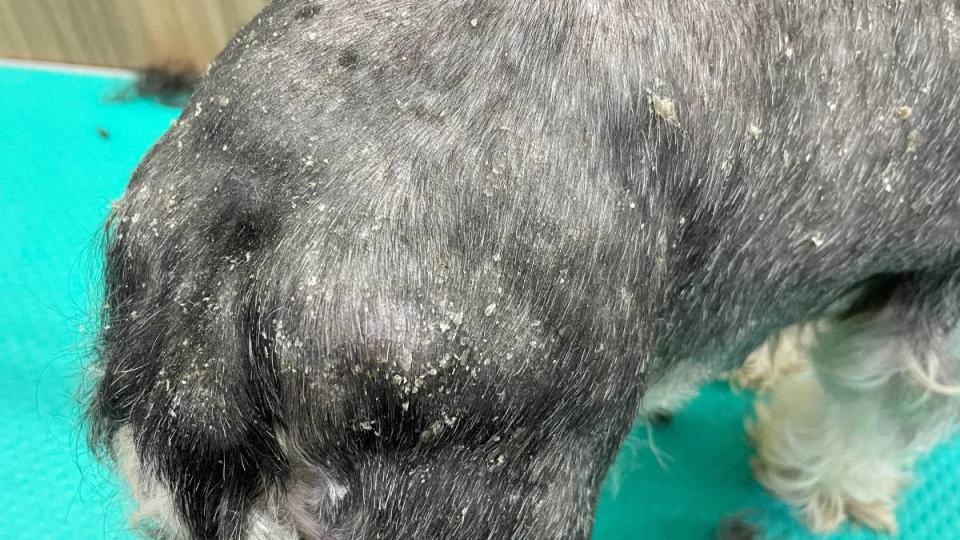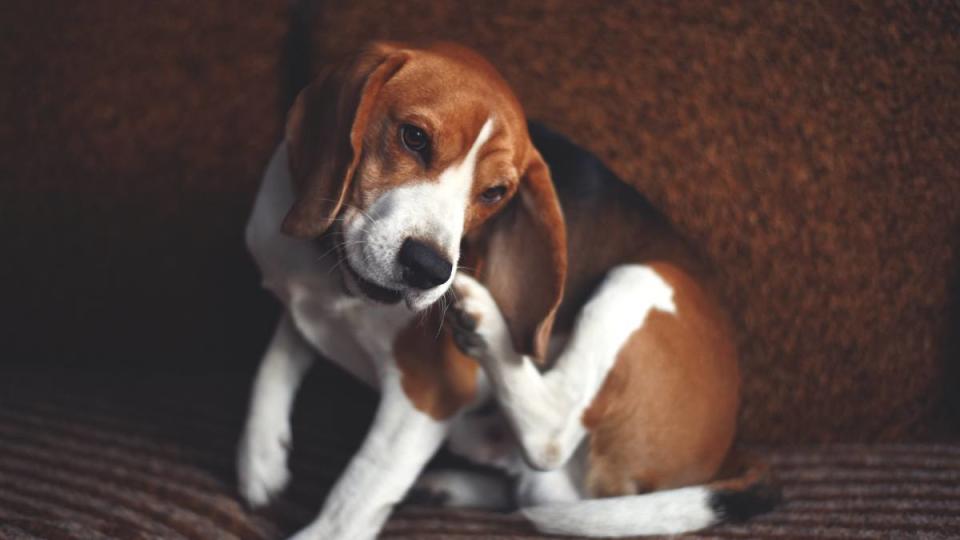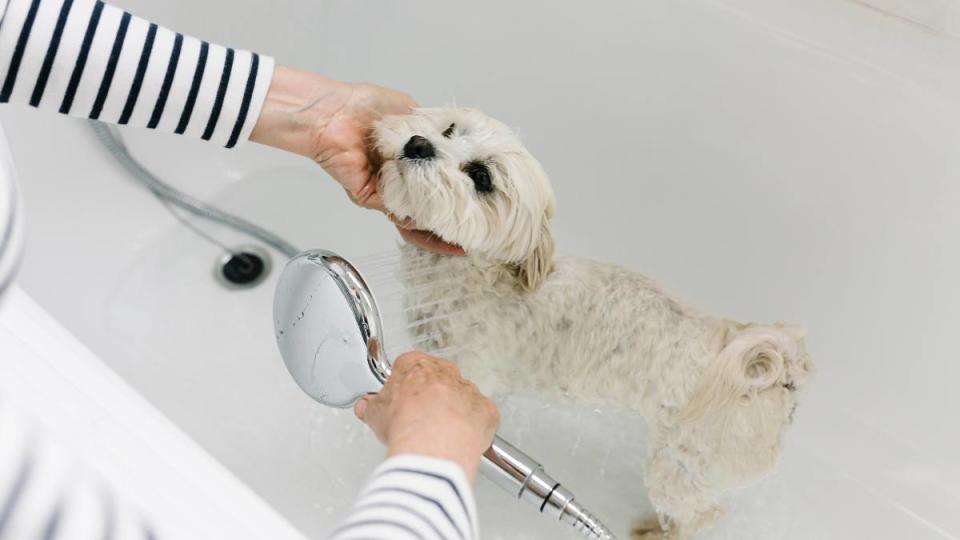Experts Share The Real Reasons Your Dog Has Dandruff + How to Treat It Naturally
Lately you’ve noticed your pal’s usually glossy coat has a smattering of dry white flakes. He might also be itching quite a bit. Seeing those flakes probably leads you to wonder: Why does my dog have dandruff? Just like human dogs can suffer from dandruff, or seborrheic dermatitis. And as it turns out, a few flakes on Rover’s coat are probably nothing to worry about. “Flaky skin in dogs can be normal due to the natural shedding of dead skin cells,” says Nicole Savageau, DVM, veterinarian at national mobile pet care service TheVets.com. “However, excessive flakiness may indicate an underlying issue.” Keep scrolling to discover what the reason could be and whether or ot you need to worry.
Why does my dog have dandruff?
According to our panel of experts, there are actually many reasons. Various factors include an imbalance in skin oils, allergies, hormonal imbalances, infections, parasites, environmental factors like dry climate, behavioral factors like stress and poor nutrition, which can all lead to visibly flakes on your cuddle bug’s coat. According to Dwight Alleyne, DVM, veterinary advisor at Betterpet.com, “Identifying the root cause of the dandruff is crucial in determining the appropriate treatment.”
If health conditions are the root cause of dandruff, you’ll need to make an appointment to see the vet. Issues like a thyroid problem or auto-immune disorders like Pemphigus, a rare auto-immunine disease, hormonal imbalance or overactive yeast on your pal’s skin can also induce white flakes. “These are things you should have your veterinarian look at as they may need to prescribe a topical ointment or other prescription,” says Dr. Allyne. “It’s also always best to get a health check if the dandruff is excessive.”

Related: Why Does My Dog Sleep on His Back? 4 Surprising Reasons, According to Pet Pros
How to know what is causing your dog's dandruff
Look at the flakes
The first thing to look at when getting to the bottom of the question, “Why does my dog have dandruff?” is to note how many flakes are present on your little guy’s coat, as well as the type of flakes. As it turns out, there are two forms of seborrheic dermatitis in canines, which can be categorized into either dry or oily forms. “The dry form is characterized by dry, flaky skin,” says Dr. Savageau. “But the oily form is associated with greasy, scaly skin.” It’s always a good idea to schedule a doctor’s visit for your pal if greasy, scaly skin is present. What’s more, dogs can have a combination of both dry and oily seborrheic dermatitis, leading to a complex skin condition that a veterinarian will most likely have to help resolve.
Consider the season
Another key factor to consider is that you might just see more dandruff at certain times of the year. Like in the summertime when allergies to environmental factors—like pollen in the air—or infestations like fleas or ticks lead to skin irritation. Alternatively, flakes may also appear in the wintertime when dry indoor heat exacerbates your buddy’s dry skin. If allergies or pesky critters are the cause of the flakes, the good news is that wiping down our pal’s coat or treating flea or tick infestations promptly can aid in resolving the issue. If dry indoor heat is the problem, adding a humidifier can help remedy the issue.

Check his diet
However, it’s not just allergies to environmental factors that can result in your pal having flakes. “While airborne allergies that come with the blooms of spring and summer can dry out the skin causing dandruff,” says Daniel Caughill, pet care specialist and co-founder of TheDogTale.com. “Other allergies like a reaction to food, or an improper diet might also be culprits.” For example, if you feed your buddy a type of food that doesn’t contain enough essential fatty oils, this could lead to his skin drying out, or if he is sensitive to certain dog food ingredients like dairy, wheat or other fillers, dandruff might occur.
Is he over-groomed?
Surprisingly, excessively grooming your little cutie can also dry out the skin — especially if you use a dryer after a bath, since overheating can dry skin out and lead to flakes.
Related: Why Does My Dog Lick Me When I Pet Her? Animal Experts Share the Surprising Reasons
What can I do to prevent my dog’s dandruff?

The experts we spoke to said if the little white flakes are caused by airborne allergies or excessive grooming, there are easy ways to remedy the problem. Here, are their top tips for grooming your pal to get pollen off his coat while avoiding adding even more of the dreaded white flakes:
Don’t over-bathe your dog
If your dog has dandruff, a rash or if you notice they scratch a lot, your first impulse may be to give them a bath. “But over bathing your dog can lead to dry itchy skin,” says Caughill. “In general, dogs should get a bath about once every three or four weeks.” Of course, if your dog rolls in something stinky, it’s fine to have an emergency bath time. When bathing, always use tepid water, as hot weather can also dry out skin.
Bathing your dog every week may be stripping natural oils from their coat and drying out their skin, which can exacerbate the issue. To combat excessive grooming, be sure to only groom long- or thick-coated dogs every 6 to 10 weeks.
Use a dog-safe shampoo
A dog’s skin has a different pH balance than human skin, so you shouldn’t use human or even baby shampoos unless you’re in a pinch. “In general, I look for natural dog shampoo brands that use gentle ingredients like oatmeal, aloe or coconut oil,” says Caughill. “You should also avoid dog shampoos that have heavy fragrances.” While this may mask your dog’s musk, it can be overwhelming for their extremely sensitive noses. One to try: Burt’s Bees for Pets Dog Shampoo with Colloidal Oat Flour.
Related: Out of Dog Shampoo? A Vet Explains Why You Should Never Use People Shampoo + What To Use Instead
Brush regularly
In between baths, it’s important to brush your dog’s hair. “Brushing helps distribute oils from the skin across the length of your dog’s fur,” notes Caughill. “This will promote healthier skin and a shiny coat, and it prevents matting that can block oxygen from reaching the skin, which will cause more issues.”
What to do when your dog has dandruff
When it comes to treating dandruff brought on by a poor diet or allergies there are some items you might already have on hand at home that can help provide your pal relief.
Give him omega 3 fatty acids
To do: Add a couple drops of oil to your pal’s food daily. “Salmon oil is a good omega 3 to use,” says Dr. Allyne. “Always try to get products for dogs rather than humans as there may be items in the human pills that will harm the dog.” One to try: Zesty Paws Wild Alaska Salmon Oil Formula for dogs.
Offer him probiotics

Adding a probiotic to your pal’s diet may also help ward off yeast infections that lead to flaky skin. The probiotics boost your pup’s immune system, which will help banish dandruff-causing yeast. One to try: NaturVet Digestive Enzyme Plus Probiotics and Prebiotics.
Apply coconut oil
This oil can help soothe your pup’s irritated or inflamed skin. To do: Apply a pea-sized amount directly onto your little rascal’s coat. He’ll love the attention and the coconut oil will moisturize dry skin, ending flakes. “You do want to be careful with this if the dog has pancreatitis,” says Dr. Allyne. “This is because you don’t want the dog licking this or ingesting it orally.”
Spritz him with apple cider vinegar
You can also mix 1 cup of apple cider vinegar and 1 cup water in a spray bottle, then shake and apply the mixture to the areas of skin where flakes occur. Simply lightly spray the area; then let it dry. The ACV will help balance the pH level of your buddy’s skin, ending flakes.
Related: 14 Brilliant Uses for Apple Cider Vinegar
How long does it take to resolve dandruff?
“The time for dandruff resolution varies based on the underlying cause,” says Dr. Savageau. “Acute cases may show improvement within weeks, while chronic conditions may require long-term management.” And if you observe persistent or worsening symptoms, consulting with a veterinarian is always a good idea, says Dr. Savageau. “Your vet will work with you to come up with a tailored treatment plan for your dog's specific condition.”
Although, in the event that after trying the natural remedies listed above for a few days, you see no improvement at all, it might be time to consult your vet. “Or if you have any other misgivings of what is causing the dandruff, always seek medical advice from a professional,” says Sally Grottini, Dog Behavior Expert for JustAnswer.com . “In some cases, such as certain allergies, your dog may need prescribed medications.”
When is dandruff a cause for concern?
Concern arises when flakiness is accompanied by symptoms like itching, redness or hair loss or if Rover’s dandruff is accompanied by red, raised or moist lesions, pain or itchiness. These symptoms all warrant a visit to your veterinarian to rule out more serious dermatological conditions. “How your vet addresses dandruff will depend on the specific cause,” says Dr. Allyne. “This may involve medicated shampoos specifically designed to treat dry skin or possible treatment for any infections present.”
For more on dogs, click through the links below!
Why Does My Dog Stare at Me? Veterinarian Explains What They’re Trying to Tell You
Dog Poop on the Carpet? These Easy Pro Tricks Will Get It Deep-Down Clean Fast
Surprising Causes of Your Dog’s Bad Breath + Vet-Approved Ways to Get Rid of It Fast

